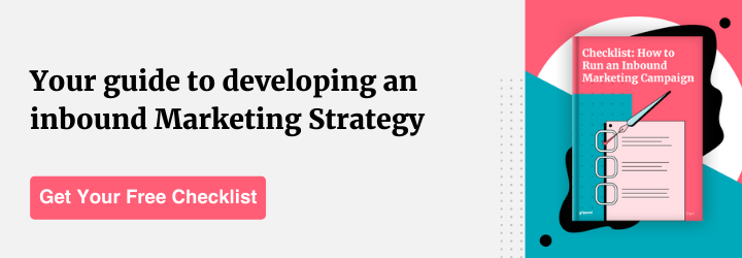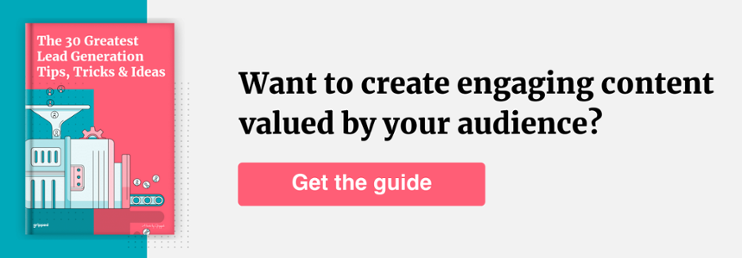Let’s be clear: inbound marketing for IT companies is critical. The majority of B2B IT sales start with online research. At this point in the potential customer’s cycle, you can attract and engage them with valuable content.1 75% of B2B buyers said that the winning vendor’s content significantly impacted their decision.
As you probably already know, B2B IT sales have long sales cycles. In addition, the products are usually fairly complex. Buyers, therefore, spend a lot of time researching their options and digesting content as they progress through the sales cycle. This is why a content-driven inbound marketing approach fits perfectly here. This approach will set you up to attract the customers you want.
This article provides a crash course on inbound marketing tactics for IT companies. We’ll help you wrap your head around the concept, build a strategy, and use these techniques to grow your company today. Let’s get started.
What is Inbound Marketing?
The “inbound” part of inbound marketing is where the strategy’s key lies. Your aim here is simple: draw potential customers to you. Practically, this means bringing them to your website — likely through educational content. Inbound marketing contrasts with outbound marketing, which is the traditional method of pushing messages out to potential customers.
Successful inbound strategies require you to create content that demonstrates your relevance, highlights how you are helpful, and shows that you’re generous with your knowledge. Hubspot suggests that you need to “attract”, “engage”, and “delight” your audience to be successful in this area.
With all of this in mind, inbound marketing can include:
- Content (organic blogs of various types, articles, eBooks, infographics)
- Social
- Email campaigns
- Lead nurturing / qualification
For your inbound marketing efforts to succeed, you’ll want to strive to give up-to-date and insightful information about your potential customer’s market, including how you see their environment and how you understand the unique challenges they face. You can also offer thoughtful, useful advice on facing those challenges. However, this is a long-term process. Remember, your aim is to be relevant to their issues, not immediately sell them on your product or service. To do this, you’ll need to properly analyse the target audience.
How to develop an inbound marketing strategy
Step 1: Build understanding.
First, in order to really add value through your digital marketing efforts, you need to clearly define your target audience and the potential personas of your buyers. Once you’ve identified a persona, ask yourself:
- What do they care about?
- What might someone in their position be interested in?
- Are there tangential matters that they are also likely to be interested in?
- What kind of scenarios are they facing that have brought them to the search engine looking for answers or a solution?
- Who are the decision-makers for them?
- Who are the influencers in this space?
Your team will probably have some idea of these answers from their existing interactions with customers. Still, it’s worth drawing them together in a systematic way
In light of your analysis, it might also be useful to refresh your analysis of your own product or service offering. Mainly focus on what it solves for the target audience you’ve identified and defined and what it doesn’t. This could include thinking about customer company sizes, specific niche markets they may operate in, how they work, or their financial situation.
Putting these two together can help you inform your digital marketing strategy. It can also help you hone in on the “conversion path” that such a persona would pass through to convert to being a paid customer.
Step 2: Add value
Once you have your target audience and buyer personas clear, consider the pain points or decision points they are facing and resolve them. You’ll need to create content that offers practical advice on solving those issues or making these decisions and helping them in the scenarios you have identified. You can even aim for “thought leadership”-style content that is more removed from your product or service but may interest the audience in general.
Your inbound marketing content can be blogs, articles, graphics, or even “hook videos” that bring users to your site and build trust with your target audience. Blogs are especially effective as they can be optimised to be easily indexed and show up in search engine results. In order to make sure your content is found and returned to users by search engines, you need to consider your SEO (search engine optimisation) strategy as you create your content. Don’t leave it till after!
Step 3: Think about your SEO strategy
If you are creating organic blogs or articles on your site, you’ll need to place a primary focus on high quality SEO. To succeed at bringing potential leads into your site and steer them onto your conversion path, your content must be informed by your keyword research. Keyword research and SEO can be intimidating if you don’t have experience in the area. Fortunately, we have some advice that can help you understand and build your SEO strategy:
Keyword Research & Deployment
This is critical if you want to focus your SEO efforts effectively.
- Keyword benchmarking: Using tools such as SEMRush and Ahrefs can provide you with useful insights as to which keywords to use, including semantically-linked keywords, and whether or not the keywords you are using are likely to be successful in driving significant traffic. They also give you an idea of the “difficulty” of a particular keyword you are testing. This can help you decide where to focus your efforts and content creation for maximum effect.
- Including these keywords: Ensuring these keywords are used in the titles of your blog posts, and articles will boost the effectiveness of your marketing content.
- Identifying and using synonyms or other combinations: Using variations of your keywords can also help boost your effectiveness.
Intent (SERP) Analysis
You should also consider carrying out intent analysis (aka SERP “search engine results page” analysis). This is done by using a private browser window to run your potential keywords through Google or other search engines. Having done this, you analyse the results that are shown to you. The aim here is to understand what users making these search queries want and match that with your content.
For example, if you find that most results are product pages, you have ascertained that people searching are not looking for informative or educational “how-to” (content) blogs. It also helps you identify whether or not the term in question is actually as relevant as you think it is.
Technical SEO
Technical SEO is the process of making sure that search engines are ‘comfortable’ with the way your page performs from a technical perspective and that search engines can crawl and index your pages from a technical perspective. This includes:
- Security: Google now prioritises pages with up-to-date SSL certificates.
- Speed: Search engines prioritise pages that load quickly and smoothly. For Google, this includes how short the time is when a user can first interact with the page and how long it takes for the largest contentful element on the screen to load, among other measures.
- Mobile compatibility: Pages that have trouble on mobile devices, or are not designed well for mobile devices, are deprioritised, especially when a user is searching from a mobile device.
- Broken Links: Search engines (and people too, of course) have a bad experience when a website has broken links within it. These could be because content has moved or URLs have changed. Make sure your site is not full of 4XX or 3XX errors! Do a tidy up to ensure that URLs are as short as possible, and that they work!
- Duplicate Content: Google doesn’t like it if your website has duplicate content, so check that your structure and content are free of duplications.
- Schema Markup: This is a process of adding extra code to a webpage that helps search engines understand the “context” of a word, phrase, picture, video, or another element. A common example given is the word “avatar”. A search engine doesn’t know if this refers to the movie Avatar or an online representation of a person’s avatar. Schema markup would tag this appropriately so that the search engine could choose the correct page for the user’s needs. You can also tag article titles, the author (as opposed to the name being someone mentioned), and multiple other types of content. It’s a bit of work to do this, but it can significantly improve results.
Step 4: Content and campaigns roadmap
Once you have covered the basic content through the writing/commissioning of organic blogs, “how-to” articles, etc., and shared these on your website and social media, you can begin building out your content marketing material. Here, the aim is to cover different points in the buyer’s journey that you identified during the analysis phase.
A good example of a next step for engaging and informing your potential customers is to provide a free ebook. Ebooks are higher value offerings than blog posts but are a natural next step once a user has found your blog helpful content, informative, and generous. Ebooks are often exchanged for customer information as higher-value offerings, such as a validated email address or even a phone contact and name.
Automated email campaigns are perfect for follow-up once you have a potential buyer’s email address. However, it is important to qualify your leads to ensure that they are really potential buyers. In the case of B2B, they are decision-makers who can actually make the buying decisions!
Paid social and paid search can also help you drive more inbound marketing traffic. Paid social involves paying social media companies (Facebook, Twitter, and especially for this purpose, LinkedIn) for more visibility. Paid search also provides you with more visibility and paid clicks through search engines.
You can also increase your company’s normal social media activity or “earned social” (remember to encourage key team members to get active too, rather than just the official company accounts). Engage constructively and helpfully in conversations and trends. When appropriate, and remembering that you are not rushing to sell, you can put out content and links to bring users onto your website (blogs, ebooks, etc.) and into your sales pipeline.
Is there anything special about inbound marketing for IT companies?
Inbound Marketing must be designed to suit the specifics of the product or service being sold. For IT companies, products & services are technical. They often require a customer to have some specific knowledge to understand the offering and reach a decision. Therefore, the sales process is a bit more complicated compared to other products or services.
As mentioned in the introduction, Inbound Marketing Strategies are ideal for boosting sales for B2B IT companies. However, it is worth taking note of a few specifics for these more specialised environments:
- SaaS and tech companies need to use a free trial/freemium product/demo as part of your pipeline, where possible.
- Free trials may not always be possible, for example, if you are an MSP (managed service provider). However, it still might be worth considering incorporating any software into your marketing if your offering includes it.
- Demos in the form of walkthroughs or case studies (videos) can be deployed even if providing a limited-time software trial is not possible, practical, or valuable.
- By nature, complex IT products can be hard to analyse in terms of ROI and long-term value. Explaining the ROI of your offering is an important strategy to consider and may be helpful for a decision-maker. Consider using ROI calculators or ROI-based case studies where possible.
Inbound marketing is always about adding value
The goal of inbound marketing is to draw users to your site. As we’ve explained above, to do this, you need to understand your audience, and provide them with practical advice, whether or not the advice can be used with your product. Building useful, engaging content tailored to your audience’s needs will help you build trust. Meanwhile, keeping an active focus on SEO will maximise your chances of reaching your intended audience and getting them into your sales pipelines. Once you have covered the basics, you can start to deploy more advanced strategies to make content that matches the needs of your audience as they move through the process.
You know your market, your product, and your audience better than anyone, but you may not have a full grasp of how inbound marketing needs to be designed and executed to drive results. We hope we’ve provided a roadmap that can help you get started. However, it might still be valuable to bring in outside help that understands the technicalities and intricacies of inbound marketing. Get in touch if you want help putting this all into context and then executing your plan. We’ll provide a free growth audit and then work together to bring leads to you and change the way you do marketing and sales for the better.
1 How To Turn B2B Buyers Into Sales Leads, According To Data


